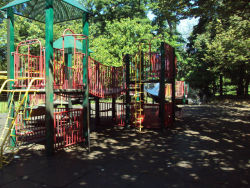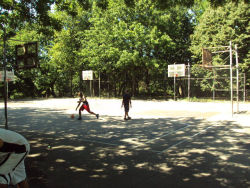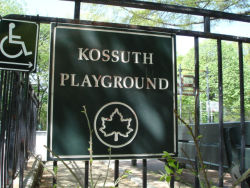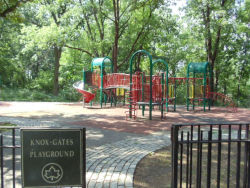Mosholu Parkway
Knox-Gates Playground
This playground honors Revolutionary War generals Henry Knox (1750-1806) and Horatio Gates (1727-1806). Boston-born Knox was the first Secretary of War under the United States Constitution. Gates was born in England, defecting from the British Army to fight on behalf of American independence. After distinguished service, both men went on to assist in the organization of the new government of the United States.
The Revolutionary War began with the battles of Lexington and Concord on April 18, 1775. On June 17, Knox fought at the battle of Bunker Hill, in which 1,000 British and 450 American soldiers were killed. Following the extensive British losses, Knox won acclaim as the leader of a re-fortification expedition that brought tons of captured arms from Fort Ticonderoga to Dorchester Heights. Knox’s success in taking control of Dorchester Heights, from which Boston was an easy target for the British, was a crucial factor in forcing a British withdrawal from the city. A year later, Knox led George Washington’s troops across the Delaware River in a successful attack on Trenton, New Jersey.
Before the war’s end, Knox established an artillery school that became the predecessor of the United States Military Academy at West Point. He was eventually promoted to Brigadier General, and in 1785, he became the country’s first Secretary of War, a post he continued to occupy under the presidency of George Washington (1732-1799).
Gates served in the British army in the French and Indian War. After his retirement in 1772, Gates left England and moved to a farm in present-day West Virginia, where he supported the Colonial cause at the onset of the Revolution. Due to his exceptional military experience, Gates gained the post of general. He led troops against General John Burgoyne’s forces at Stillwater and Saratoga, New York, emerging victorious on October 17, 1777.
During the winter of 1777-78, Gates took part in the Conway Cabal, an attempt to take power from Washington. Gates left the war for a while but was soon recalled and given command of the Southern forces, where he suffered defeat at the hands of British General Charles Cornwallis. He was replaced by Nathanael Greene, and spent the remainder of the war serving in Washington’s command. In 1790, Gates left his Virginia plantation, sold his slaves, and moved to a 90-acre farm at what is now 2nd Avenue and 24th Street in Manhattan. He then served on the New York State Assembly in 1800.
Knox-Gates Playground, on Knox Place, Gates Avenue, and the Mosholu Parkway, was constructed on May 31, 1996, with $337,000 in funds from Borough President Fernando Ferrer. The site is one of a group of properties acquired for the construction of the Mosholu Parkway in 1888. A wrought-iron fence surrounds the playground, which has two play structures with safety surfacing, benches, and many fanciful touches. A large compass rose design in red, blue, and gray is set into the pavement before the entrance, and hand-sized iron maple leaves decorate the fence. In addition, there is a play structure in the shape of a six-legged insect with two large purple eyes.
Check out your park's Vital Signs
Clean & Safe
Green & Resilient
Empowered & Engaged Users
Share your feedback or learn more about how this park is part of a
Vital Park System




